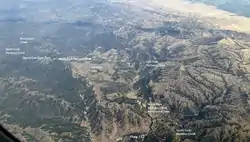North Fork Pacheco Creek
North Fork Pacheco Creek is a 19 miles (31 km) tributary stream of Pacheco Creek, in Santa Clara County, California. Originally it was considered the upper reach of Pacheco Creek.[2] Its source is at an elevation of 2,360 feet (720 m) at 37°11′17″N 121°25′42″W on a mountain side in Henry W. Coe State Park and is the headwaters of the Pajaro River watershed.[3]
| Pacheco Creek | |
|---|---|
 Aerial Photo of North Fork Pacheco Creek Watershed in the Diablo Range of Northern California | |
| Location | |
| Country | United States |
| State | California |
| Region | Santa Clara County |
| Physical characteristics | |
| Source | |
| • location | Henry Coe State Park |
| • coordinates | 37°11′17″N 121°25′42″W[1] |
| • elevation | 2,360 ft (720 m) |
| Mouth | Confluence of North Fork Pacheco Creek and South Fork Pacheco Creek |
• location | 16.5 mi (27 km) east of Gilroy |
• coordinates | 37°02′42″N 121°17′23″W[1] |
• elevation | 430 ft (130 m) |
| Basin features | |
| Tributaries | |
| • left | Mississippi Creek, East Fork Pacheco Creek |
History
In 1993, archeologist Mark Hylkema documented eight different Native American sites on the Andresen Ranch along the lower North Fork Pacheco Creek, dating from 1000 B.C. to 500 A.D. These included multiple human burials, both adult and juvenile. He concluded that the interior of the Diablo Range north of Pacheco Pass was extensively occupied.[4] Although Central Valley Yokuts may have utilized this area, archeologist E. Breck Parkman, who studied sites along upper North Fork Pacheco Creek, summarized evidence that the primary occupants were Ohlone, of the Tomoi, Locobo, and Cobo Ohlone peoples. These peoples were removed to Missions Santa Clara and Santa Cruz between 1800 and 1808.[5]
Watershed
The North Fork Pacheco Creek has two main tributaries. Furthest upstream is the Mississippi Creek[6] tributary of North Fork Pacheco Creek. It is 9.5 miles (15.3 km) long and has an impoundment (Mississippi Lake) above 2,100 feet (640 m) elevation. Mississippi Creek sources on Bear Mountain[7] on the northern side of Henry W. Coe State Park. The North Fork Pacheco Creek also receives the 6 miles (9.7 km) long East Fork Pacheco Creek,[8][9] at Chimney Rock[10] before reaching Pacheco Reservoir and Dam, the latter just north of Highway 152.
The mouth of North Fork Pacheco Creek is at its confluence with South Fork Pacheco Creek at an elevation of 430 feet / 131 meters where it forms the head of the Pacheco Creek mainstem west of Pacheco Pass.
In 2019, the U.S. Bureau of Reclamation released a draft environmental report that the 100-foot earthen (North Fork) Pacheco Creek dam be replaced with a $1.1 billion dam that would increase reservoir capacity from 5,500 acre-feet to 140,000 acre feet, making it larger than Anderson Reservoir, currently the largest reservoir in Santa Clara County.[11] However, environmentalists have proposed a smaller dam on only the East Fork Pacheco Creek, so that only one stream would be blocked instead of two, and enabling the opening of the North Fork Pacheco Creek to spawning runs of steelhead trout to the perennial waters in the upper watershed within Henry Coe State Park.
Ecology
Pacheco Reservoir (North Fork Dam) is an impassable barrier to in-migrating steelhead trout (Oncorhynchus mykiss), preventing access to the nearly 34.5 miles (55.5 km) of stream consisting of North Fork Pacheco Creek, Mississippi Creek and East Fork Pacheco Creek.[8] However, resident rainbow trout (the landlocked form of steelhead trout) successfully rear in fast-water habitats in the headwaters but cannot in-migrate because of the dam, likely leading to genetic inbreeding depression, as in other nearby streams with passage barriers.[12] In many years in late spring, prior to reservoir releases for agriculture, low stream flows and high water temperatures severely impact steelhead fry and small juveniles. Professor Jerry Smith of San Jose State University recommended that releases from the dam in at least April (if not May) would be essential to enable successful outmigration of steelhead smolts downstream.[13] Other native fish in North Fork Pacheco Creek include Monterey sucker (Catostomus occidentalis mniotiltus) and Sacramento pikeminnow (Ptychocheilus grandis).[14]
See also
References
- U.S. Geological Survey Geographic Names Information System: North Fork Pacheco Creek
- See Gilroy Hot Springs, 1918 Geographic Survey Topographic Map
- U.S. Geological Survey Geographic Names Information System: North Fork Pacheco Creek
- Mark G. Hylkema (1993). "Some Perspective on Upland Settlement Patterns of the Central Diablo Range of California" (PDF). Proceedings of the Society for California Archaeology. 6: 99–119. Retrieved March 7, 2020.
- E. Breck Parkman (1986). "Cupule Petroglyphs in the Diablo Range, California". 8 (2): 246–259. Retrieved March 7, 2020. Cite journal requires
|journal=(help) - "Mississippi Creek". Geographic Names Information System. United States Geological Survey.
- "Bear Mountain". Geographic Names Information System. United States Geological Survey.
- U.S. Geological Survey. National Hydrography Dataset high-resolution flowline data. The National Map, accessed December 29, 2019
- "East Fork Pacheco Creek". Geographic Names Information System. United States Geological Survey.
- "Chimney Rock". Geographic Names Information System. United States Geological Survey.
- Paul Rogers (August 9, 2019). "Environment report out on new $1 billion dam proposed for Santa Clara County". San Jose Mercury News. Retrieved March 7, 2020.
- John Carlos Garza, Devon A. Pearse (March 2008). Population genetics of Oncorhynchus mykiss in the Santa Clara Valley Region (PDF) (Report). Santa Clara Valley Water District. Retrieved 2020-06-18.CS1 maint: uses authors parameter (link)
- Jerry Smith (2007). Effects of Operation of Pacheco Reservoir on Steelhead (Report). San Jose State University. Retrieved 2016-02-07.
- "Fish Species by Location - 'Upper North Fork Pacheco Creek-180600020201'". University, Division of Agriculture and Natural Science. California Fish Website. Retrieved 2016-02-06.